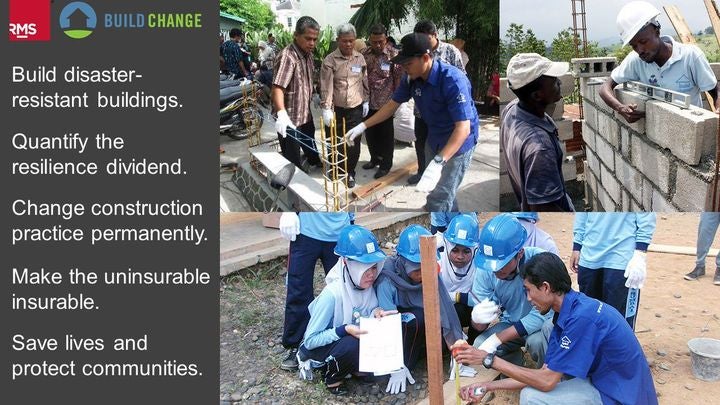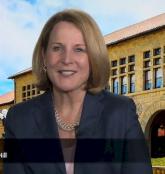A postcard from Manila…
Situation: rapid, uncontrolled urbanization and limited enforcement of building codes.
Complication: unwieldy administrative procedures, limited funding, a lack of technical expertise and #NIMTOO.
Result: an alarming rise of building vulnerability in hazard-prone communities putting millions of low-income people at extreme risk.
While many local government officials recognize this problem, progress is painfully slow. Housing vulnerability continues to rise. What to do?
The Issue of Our Age?
According to my favorite bricklayer, Dr. Elizabeth Hausler, housing vulnerability is the defining issue of our age. By 2030, three billion people will live in substandard homes. That’s one third of the world’s population.
Just ask Santiago Uribe Rocha, the first Chief Resilience Officer employed in a non-OECD country. In Colombia over the past 20 years, more than ten million people have moved to major cities like his, Medellín. The lack of affordable housing has led many of these low-income families to settle on the outskirts, often building haphazardly with poor quality material.
According to CENAC (Centro de Estudios de la Construcción y el Desarrollo Urbano y Regional), three out of every five new homes built in Colombia today are of “informal origin”. In other words, 60 percent live in homes that are built without any legal procedures or formal design process.
Despite acknowledging the issue, city governments often lack the means to effectively deal with increasingly vulnerable housing stock. Cumbersome bureaucracies complicate matters. In some neighborhoods, city officials require over six months to approve the retrofit of a single home.
The result: hundreds of thousands of low-income families remain significantly at risk of death, injury and destitution in an earthquake.
Change Is Building
RMS has been working closely with Build Change since 2013. By sharing research, expertise and resources, we’ve been supporting the non-profit’s preventive programs in Latin America, the Caribbean, Nepal and, most recently, Southeast Asia.

The partnership, focused on promoting the benefits of retrofitting homes for low-income families living in informal neighborhoods, is closely aligned with RMS’ overarching, societal purpose. After all, for the last 30 years, RMS’ mission has remained the same: to make communities more resilient through a deeper understanding of the impacts of extremes.
With RMS’ support, Build Change has been able to develop the basis for successful retrofit projects. Shared value abounds…
- The local governments have been convinced to effect and enforce changes to urban planning and building ordinances.
- The local construction industry has been upskilled and employed.
- The local insurers are finding new opportunities to offer affordable policies.
- The local residents now have disaster-resilient homes and insurance coverage.
Quantifying Resilience; Increasing Institutional Urgency
Catastrophe risk models have been vital to this process. By combining science, technology, engineering and data to simulate the potential impacts of future disasters, RMS modeling puts a number on the potential impacts of “informal” housing. Moreover, the models can be used to evaluate how risk might reduce if mitigating measures are put in place.
A virtuous circle often results: quantifying the value of building practices drives funding; funding helps protect more communities; more communities protected demonstrates the value of resilient building practices; more funding follows.
For example, in 2016 RMS quantified the cost-effectiveness of a proposal for a scaled retrofit program in Bogotá, Colombia. Preliminary analysis showed that over 120,000 deaths and US$2.8 billion could be avoided in a 1-in-200-year event by retrofitting homes in the five neighborhoods studied.
RMS and Build Change also demonstrated that the project would deliver an attractive return on investment. Analysis showed that the retrofits could be completed using existing local skills, with minimal training, and for less than half the price of demolishing to rebuild.
In this case, the modeled output did not just increase the institutional urgency to deal with the problem of vulnerable housing. The analytics also contributed to the wider acceptance in Colombia of retrofitting as a viable solution.
Now What?
In approximately five years of formal partnership, RMS and Build Change have collaborated to greatly improve the safety of seismically-vulnerable communities. By combining our risk modeling expertise and institutional support with Build Change’s technical knowledge and grass roots approach, we’ve not only demonstrated that retrofitting in vulnerable neighborhoods is possible. We’ve also shown it’s a cost-effective way to save lives and livelihoods.
As a result, the Government of Colombia recently made the retrofitting of 600,000 homes an urgent, national priority.
Of course, our work in Latin America is by no means done. And collaborations with Build Change continue in Haiti and Nepal as well.
Immediate attention, however, has shifted to the Philippines. It’s too early to judge the outcomes. But with 69 million low-income people living in 15.6 million vulnerable homes today, the potential to make a difference is huge.
By quantifying that potential, we hope to develop a compelling business case to address what is arguably the issue of our age. By putting a number on the resilience dividend, we hope to attract the #ResilienceFinance needed to make some of the world’s most densely populate cities significantly safer.






